Onsen Tamago, or “hot spring eggs“ in Japanese, are slowly poached in the shell in volcanic hot spring water. This creates the most luxurious, silky egg whites and custard-like yolks. Learn how to make this delicious, easy recipe at home with my foolproof method.
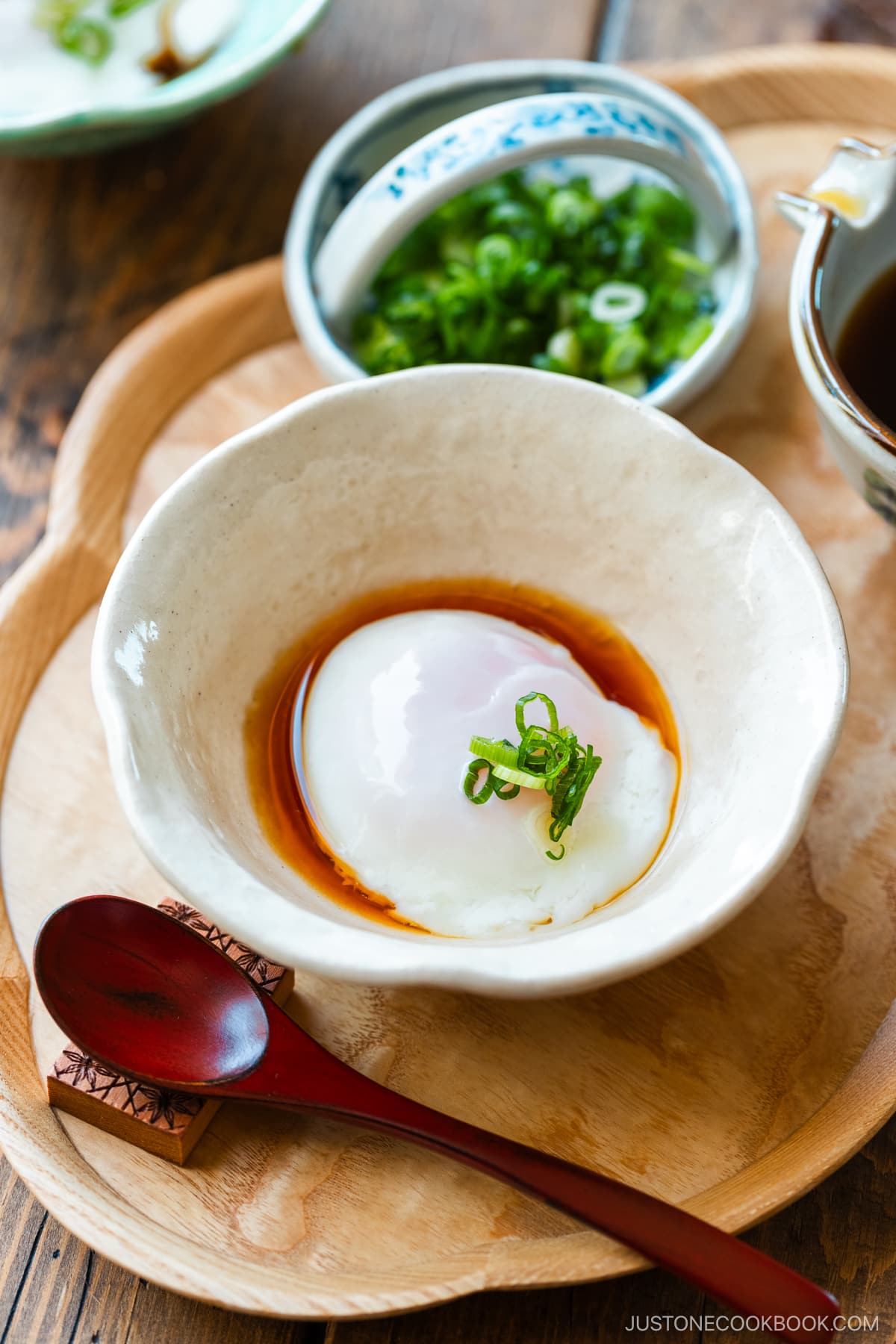
Japan is world-famous for its 30,000+ natural hot springs or onsen. Visitors can take a relaxing and therapeutic bath at one of Japan‘s 3,000 onsen resorts and stay at a resort’s ryokan or traditional inn to experience their warm hospitality and delicious cuisine.
When I stay at a ryokan, one of their breakfast dishes that I eagerly anticipate is onsen tamago (温泉卵, “hot spring egg”). Why? Because this Japanese-style poached egg has the silkiest and creamiest texture. It‘s so comforting and satisfying to eat with hot steamed rice in the morning!
Back in the U.S., I find myself craving onsen tamago. Luckily, it’s easy to make this luxurious egg dish in your own kitchen. Whether you’re an onsen-tamago lover or first-time eater, let me show you my foolproof method today so you can make it at home anytime!
Table of Contents
What’s Onsen Tamago?
In Japanese, onsen means “hot spring” and tamago means “egg.” Onsen tamago (温泉卵), also known as ontama (温玉), is an egg that’s slow-poached in the shell using volcanic hot springs water.
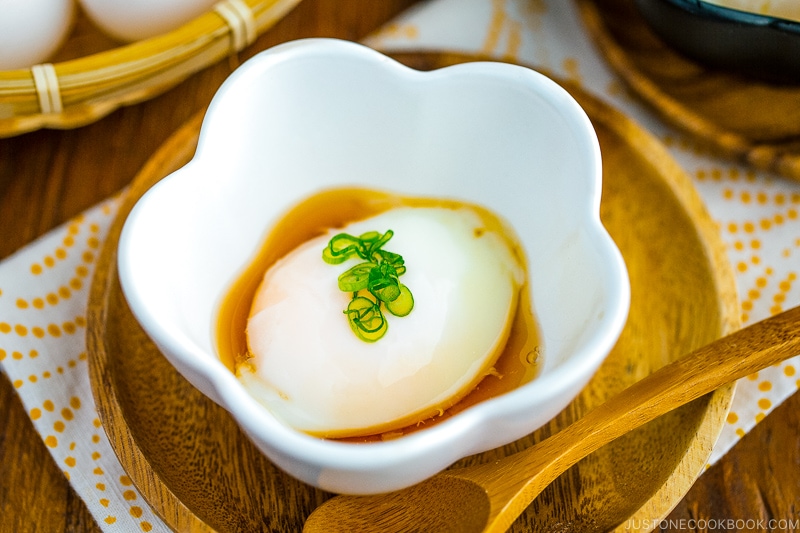
What’s so special about these eggs? They are perfectly poached inside their shell, and the white is silky, creamy, and softer than the half-cooked yolk. This is the opposite of a typical poached egg cooked in simmering water, with a firm white and soft yolk.
The Chemistry Behind Onsen Tamago
We can achieve this special texture because the egg yolk and white solidify at different temperatures. The yolk solidifies at 158°F (70°C) and the white solidifies at 176°F (80°C).
To achieve perfect onsen tamago with creamy and silky whites and soft-cooked yolks, we must cook eggs in hot water at a constant temperature of 149–154°F (65–68°C) for 30 minutes or 154–158°F (68–70°C) for 20 minutes. This mimics the temperature of Japan’s volcanic hot spring waters.
Disclaimer: Many people in the world, including the Japanese, consume uncooked eggs in their cuisine. However, according to the FDA, eggs should be cooked to 165°F (74°C) in order to be considered safe. Please know that the perfect temperature for cooking onsen tamago is below the guideline. There is a risk of salmonella by consuming undercooked eggs.
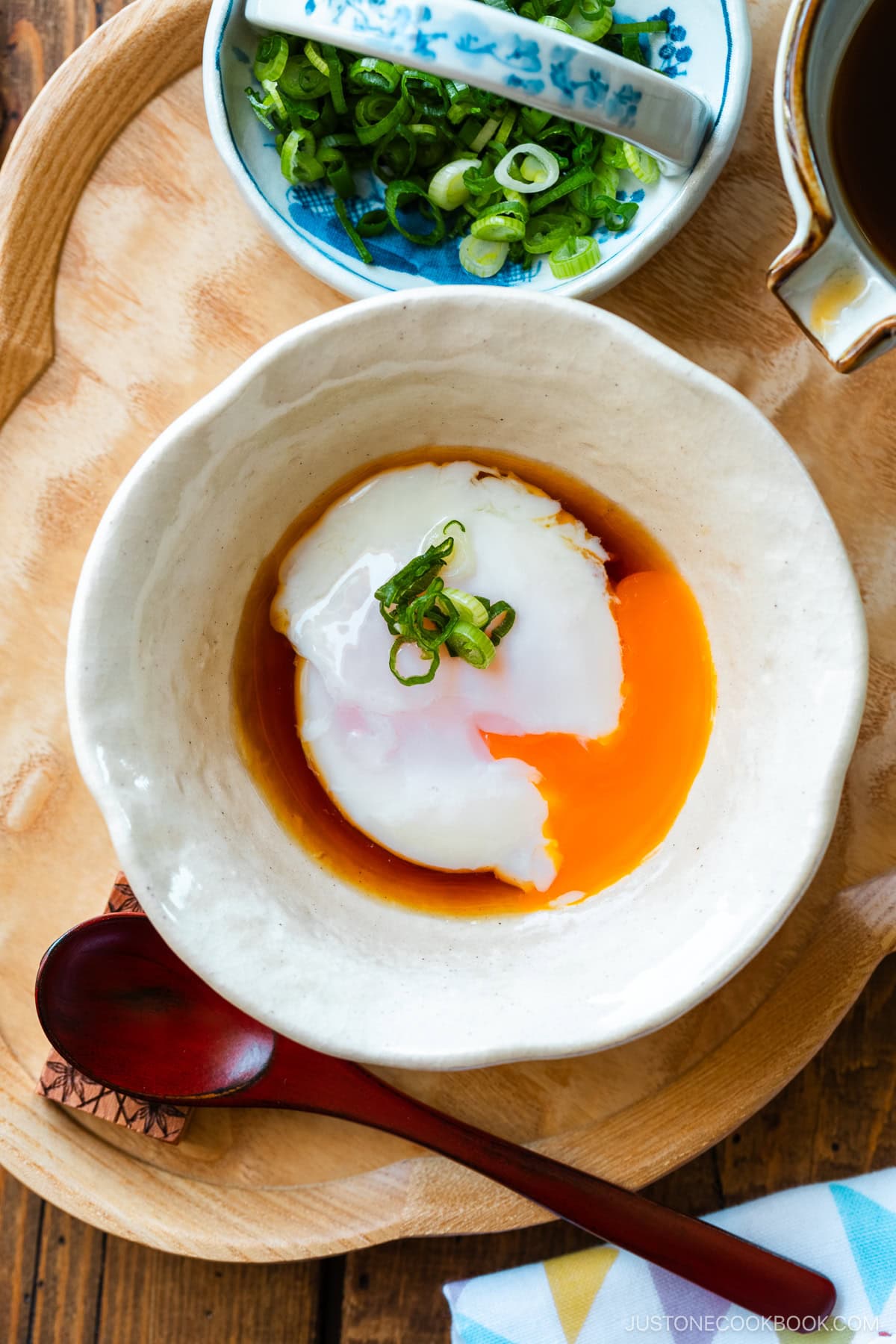
Why This Recipe Works for Everyone
As we don’t have a steady supply of hot spring water at a constant temperature, here’s a method that works for typical home kitchens. This technique does not require special equipment like a microwave, thermometer, or sous vide machine (immersion circulator). It also does not use ice cubes for cooling the cooked eggs; this simplifies things, as some of you don’t keep ice cubes handy.
Here’s what you’ll need:
- A stove, a heavy-bottomed small pot, and a ladle (I use a fine-mesh skimmer). Why a heavy-bottomed pot? It retains heat better.
- Boiling water and tap water to create an ideal starting temperature for the cooking water.
- 4 refrigerated large eggs. Cold eggs offset the higher starting temperature of the cooking water. Some recipes require eggs at room temperature, but our readers’ kitchens have different temperatures depending on where they live, and I wanted to avoid the extra uncertainty.
If you follow my recipe precisely, you will achieve perfect onsen tamago as the final result. If you change the recipe, it will affect the water temperature and you may not achieve a perfect outcome.
🙋🏻♀️ Also, keep in mind that you can customize the firmness of the yolk by increasing or decreasing the cooking time.
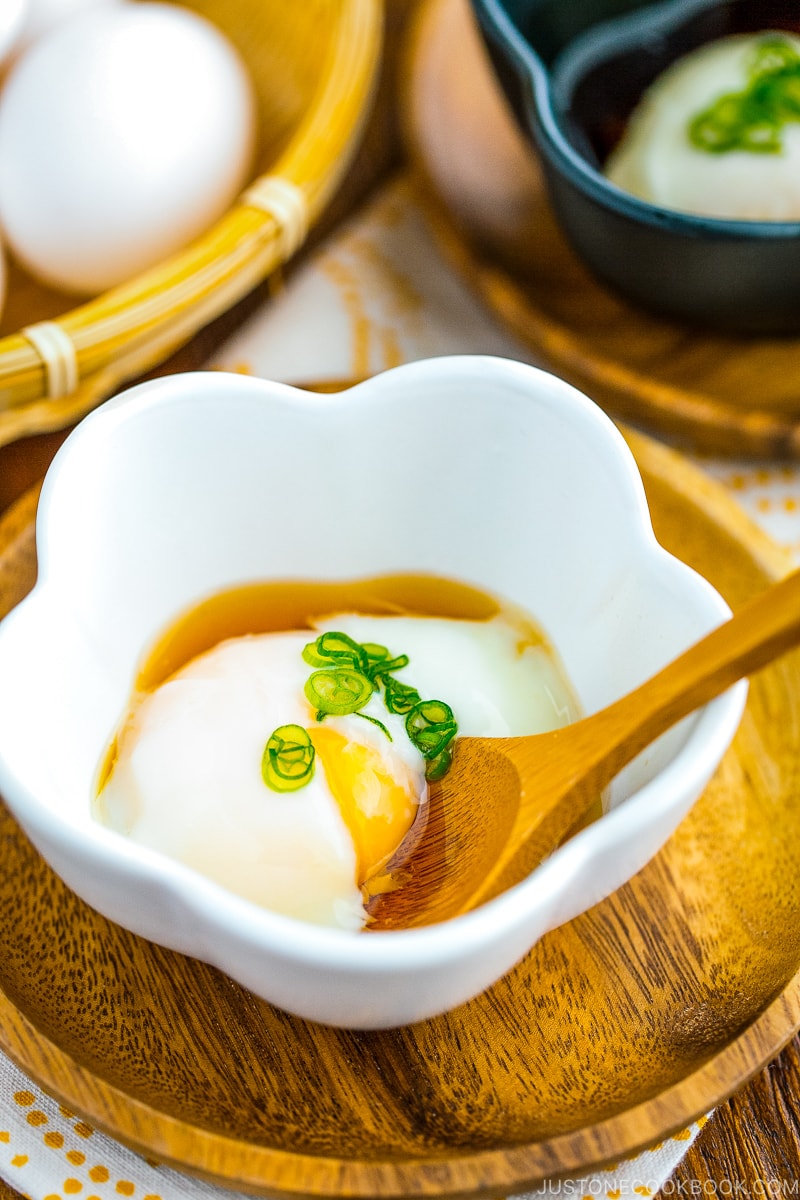
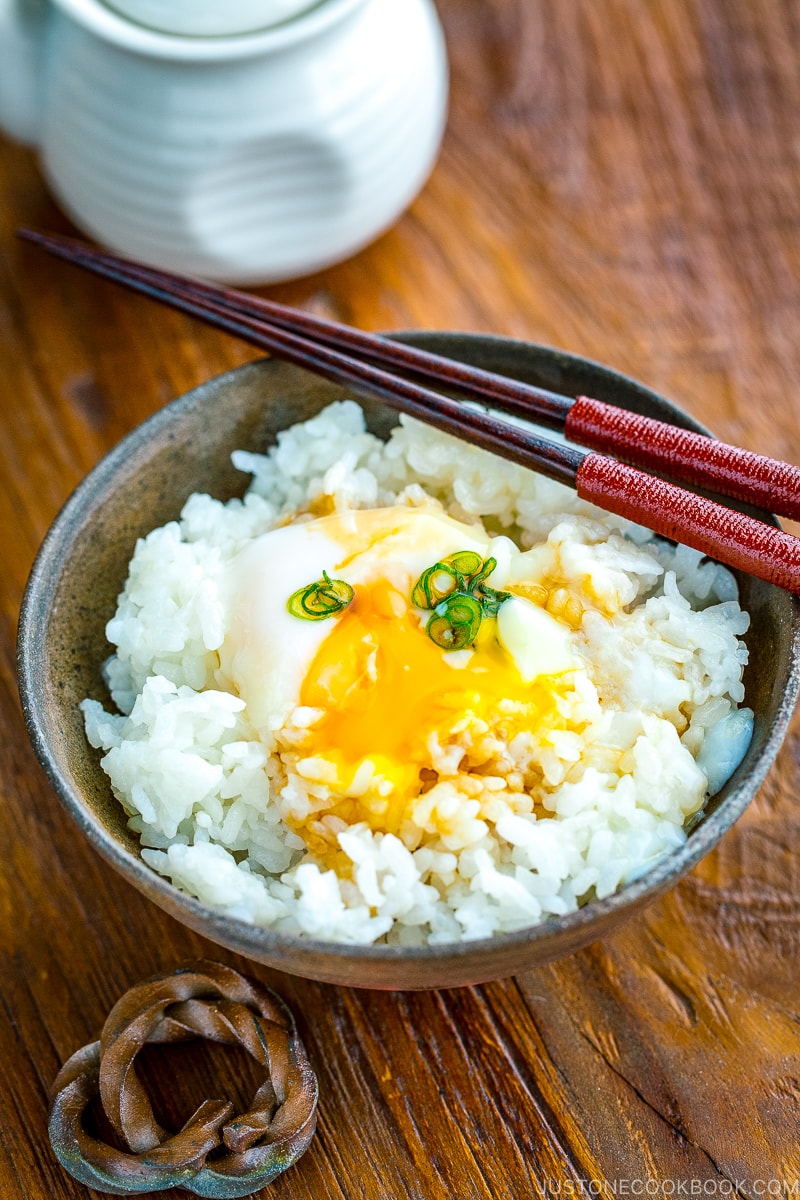
How to Make Onsen Tamago
Here are the simple instructions on how to make perfect onsen tamago without a thermometer or immersion circulator.
- Prepare the cooking water: Boil 4¼ cups (1000 ml or 1 L) of water in a small heavy-bottomed pot. Once boiling, remove it from the stove. Add ¾ cup (200 ml) of cold tap water (65°F/18°C) to the boiled water.
- My hot water temperature at this stage was 180°F (82°C).
- Cook the eggs: Gently submerge 4 refrigerated large eggs, one at a time, in the hot water. Cover the pot, set a timer, and poach for 17 minutes for a runnier yolk and 20 minutes for a creamier yolk.
- My hot water temperature gradually declined to 154–158°F (68–70°C).
- Remove from the water: Open the lid, remove the eggs from the hot water, and set aside for 5 minutes. The residual heat will continue to cook the eggs.
- The water temperature was 154°F (68°C) when I opened the lid after 20 minutes.
- Ready to serve: Serve warm or at room temperature with a drizzle of the dashi soy sauce or add one to curry rice, noodle soup, a hambagu meal, a rice bowl, or a plate of cold noodles.
FAQs
What if I don’t have a heavy-bottomed pot?
A lightweight or thin-bottomed pot is usually made with materials that may heat up and cool down more quickly than heavy-bottomed pots. Therefore, try using less cold tap water, about ⅓–½ cup (100–150 ml) instead ¾ cup (200 ml). If you try this method, keep us posted on your results in the comments below.
Can I use medium eggs?
Since they are smaller, they will cook faster. Please shorten the cooking time. FYI, a large egg without the shell is 50 grams.
How to Serve Onsen Tamago
Onsen tamago with a dashi-based soy sauce (だし醤油) is a typical choice of egg to serve for Japanese breakfast.
You can also serve onsen tamago in various dishes. I adjust the onsen tamago’s cooking time to cook the egg yolk more or less depending on how I use it. For example, I prefer a runny yolk on Japanese curry and a firmer yolk on hambagu.
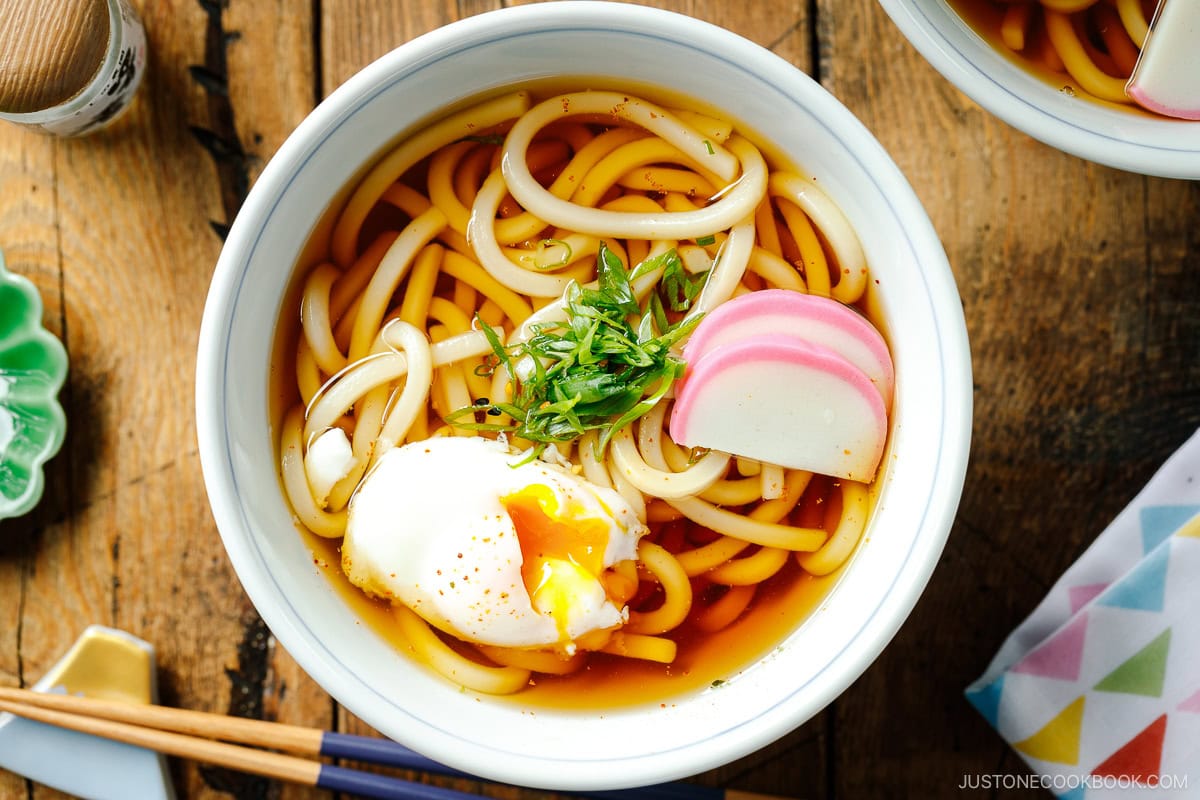
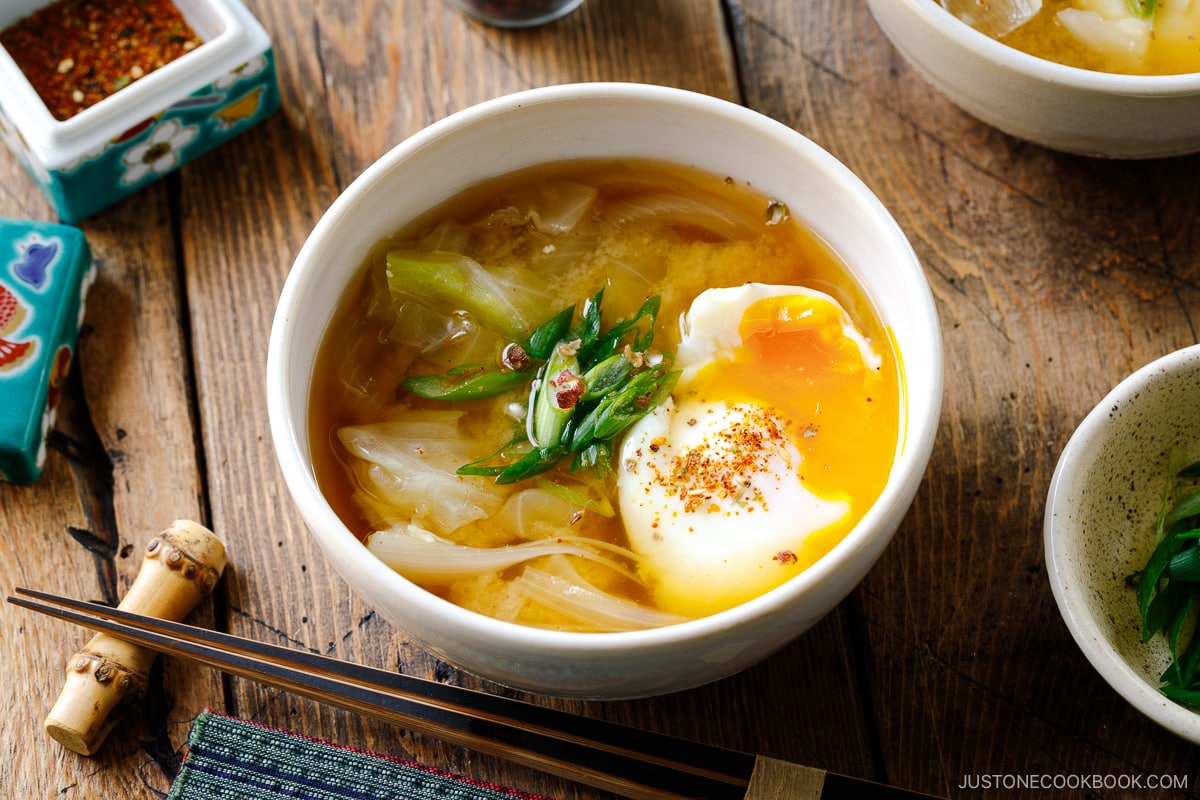
Here are some of my suggestions:
- Put it over fried rice: Kimchi Fried Rice, Garlic Fried Rice
- Top your Japanese curry rice: Japanese Dry Curry, Keema Curry, Chicken Curry, Vegetarian Curry, Beef Curry
- Add it to a rice bowl: Gyudon, Yakiniku Don, Tamago Kake Gohan
- Put it in noodle soup: Kake Udon, Cold Tanuki Udon, Vegetarian Udon, Soba Noodle Soup, Miso Ramen, Vegetarian Ramen, Shoyu Ramen, Mazesoba (brothless ramen)
- Top a main dish: Hambagu (Japanese hamburger steak), Nikomi Hambagu (stewed hamburger steak), Loco Moco, spaghetti carbonara (my favorite), Avocado Toast
- Put it in your soup and hot pot: Classic Miso Soup, Cabbage and Onsen Tamago Miso Soup, Cold Miso Soup (Hiyajiru), Zosui (Japanese rice soup), Nabeyaki Udon, Miso Nikomi Udon
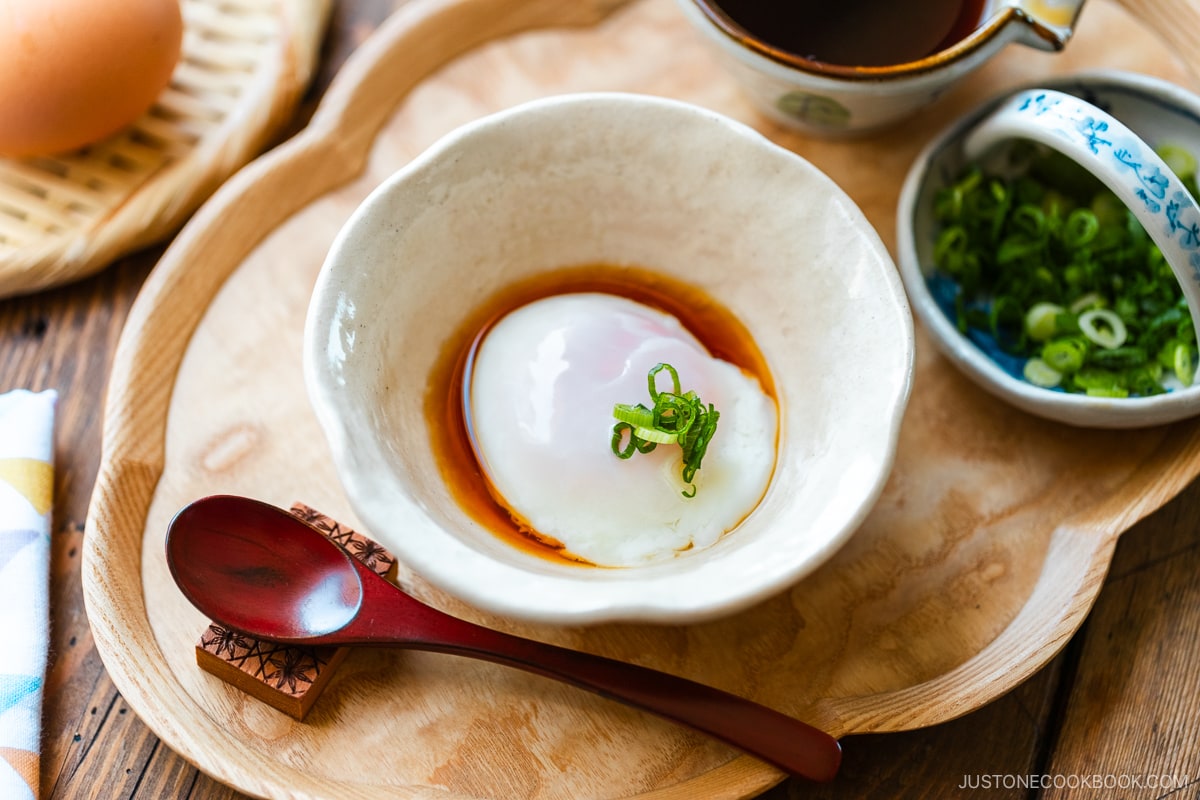
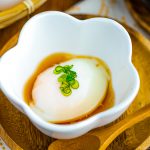
Onsen Tamago (Japanese Hot Spring Egg)
Video
Ingredients
- 4¼ cups water (1 L)
- 4 large eggs (50 g each w/o shell) (refrigerated; DO NOT use more than 4)
- ¾ cup tap water (200 ml; colder than room temperature)
For the Sauce
- ¼ cup dashi (Japanese soup stock) (4 Tbsp; use standard Awase Dashi, dashi packet or powder, or Vegan Dashi)
- ½ Tbsp mirin
- 1½ Tbsp soy sauce
- 2 Tbsp katsuobushi (dried bonito flakes) (skip for vegetarian)
For the Garnish
- green onion/scallion
Instructions
- DO NOT use scaling (x 2 or x 3) for this recipe. To achieve the correct water temperature for poaching, you'll need exactly 4 refrigerated large eggs for this recipe.
- Before You Start: You must use a small, heavy-bottomed saucepan (I use All-Clad Copper Core 2 QT saucepan) that retains heat well and is small enough to completely submerge the eggs in the measured water. If you don‘t have one, please see my FAQs section of the blog post for my suggestion. Now, gather all the ingredients.
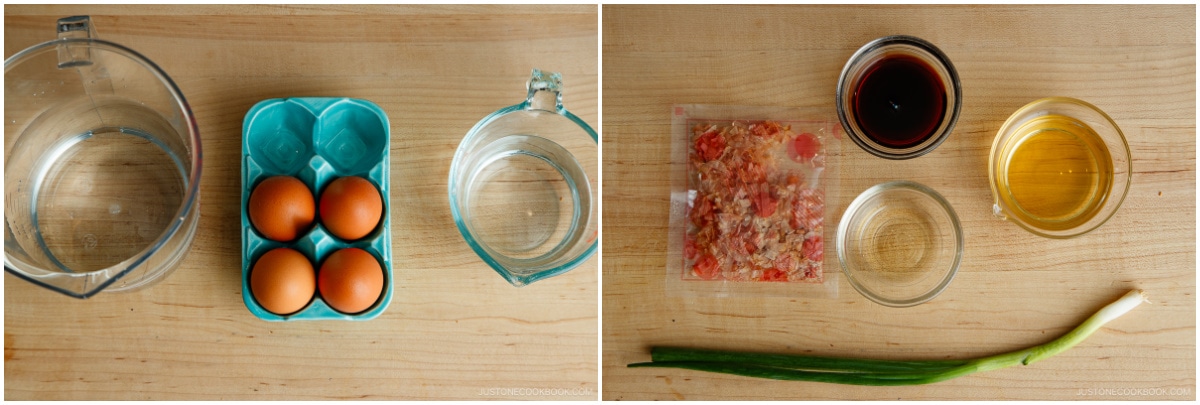
To Poach the Eggs
- To the heavy-bottomed saucepan, add 4¼ cups water (1 L). Cover with a tight-fitting lid and bring it to a boil.
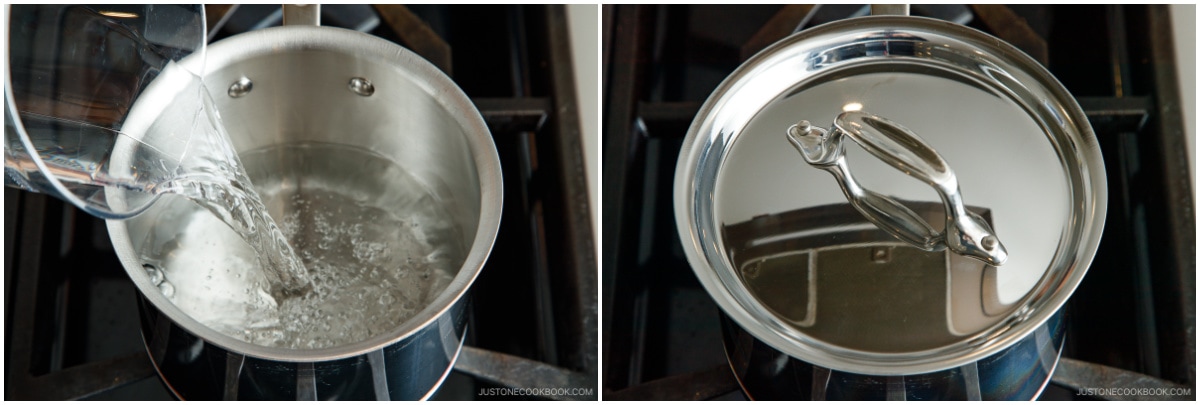
- Once boiling, turn off the heat and remove the pot from the stove. I moved my saucepan to a hot pad on my countertop. Next, remove 4 large eggs (50 g each w/o shell) from the refrigerator.
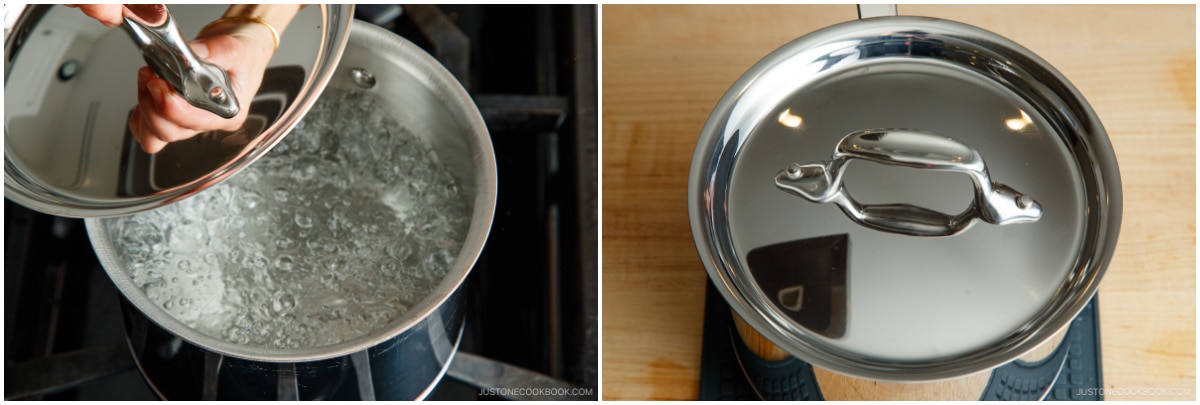
- To the pot of just-boiled water, add ¾ cup tap water (200 ml) that's colder than room temperature and stir. The hot water in the saucepan should be roughly 180°F (82°C). Then, gently submerge the cold eggs, one at a time, into the hot water using a fine-mesh skimmer. Tip: If you‘re using a lightweight or thin-bottomed pot, try adding only ⅓–½ cup (100–150 ml) of cold tap water instead.
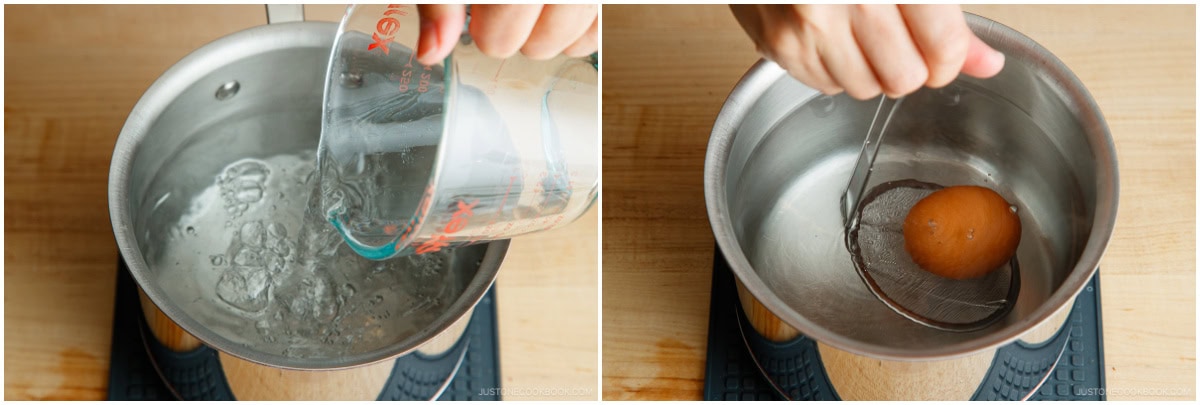
- Immediately cover with the lid and set a timer for 17–20 minutes. Poach 17 minutes for runnier yolks and 20 minutes for creamier yolks. If you follow my method precisely, the water temperature will be 154°F (68°C) when you open the lid after 20 minutes. Note: If you prefer a firmer yolk, you can experiment with a longer poaching time.
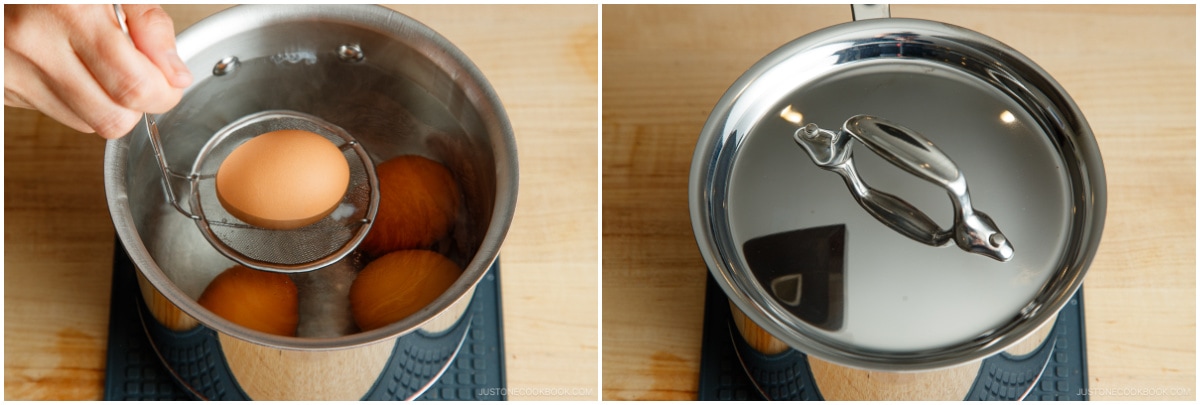
To Make the Sauce
- Meanwhile, make the sauce. Combine ¼ cup dashi (Japanese soup stock), ½ Tbsp mirin, 1½ Tbsp soy sauce, and 2 Tbsp katsuobushi (dried bonito flakes) in a small saucepan and bring it to a boil.
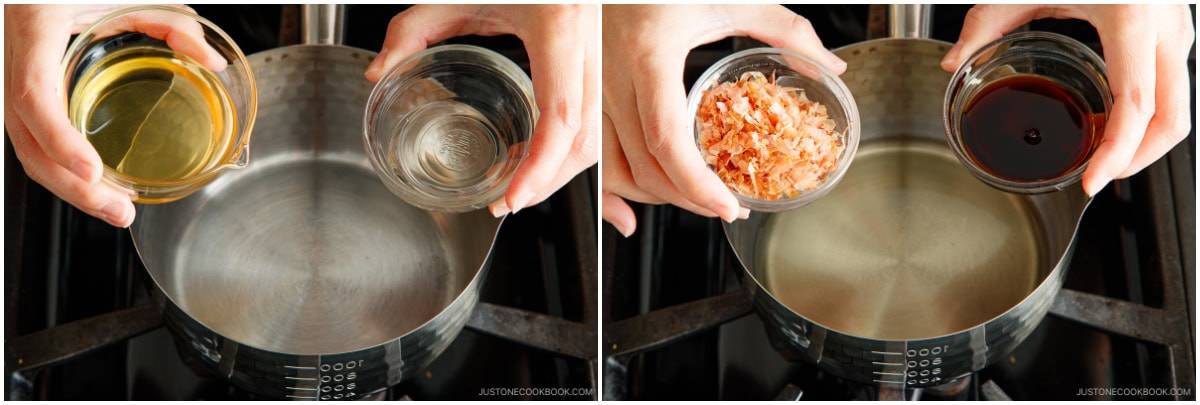
- Once boiling, turn off the heat.
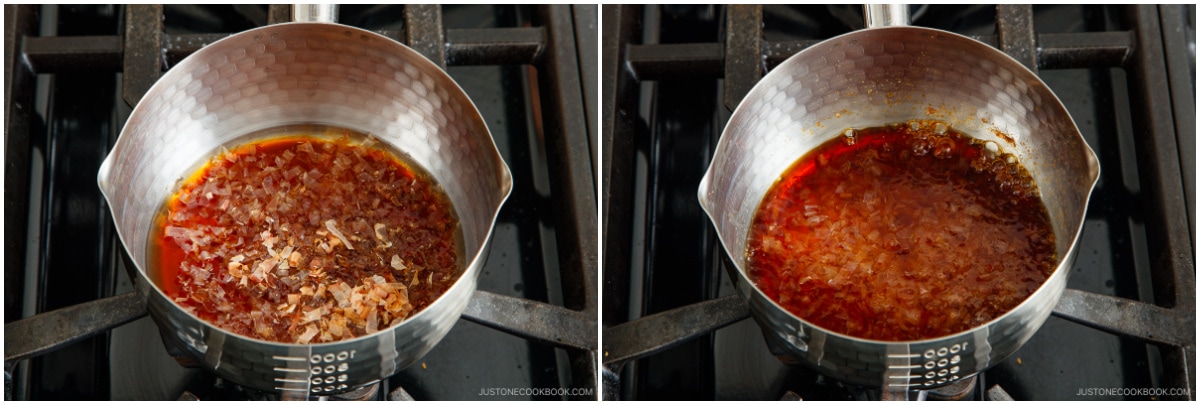
- Strain through a sieve and set the sauce aside.
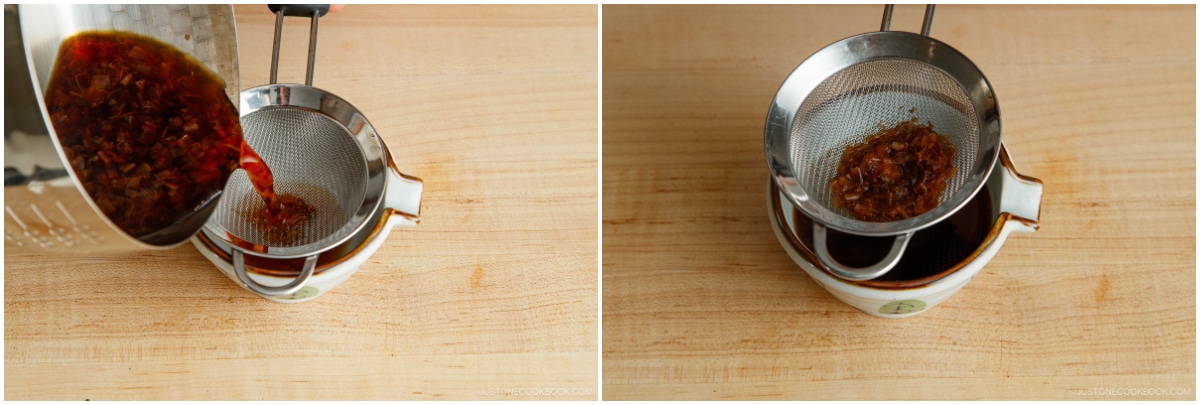
To Finish the Onsen Tamago
- After 17–20 minutes, gently take the eggs out of the water, one at a time. Set them aside for 5 minutes. The residual heat will continue to cook the eggs.
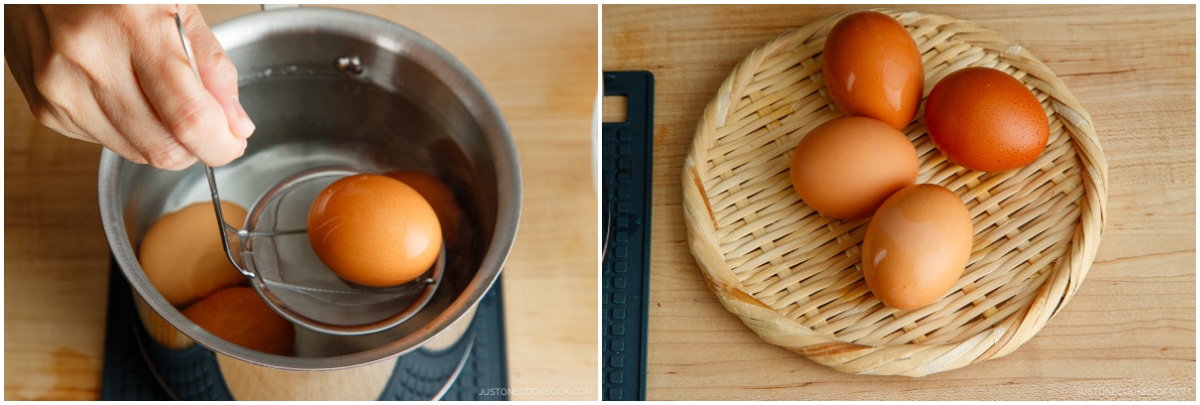
- Meanwhile, cut the green onion/scallion into thin slices and set aside.
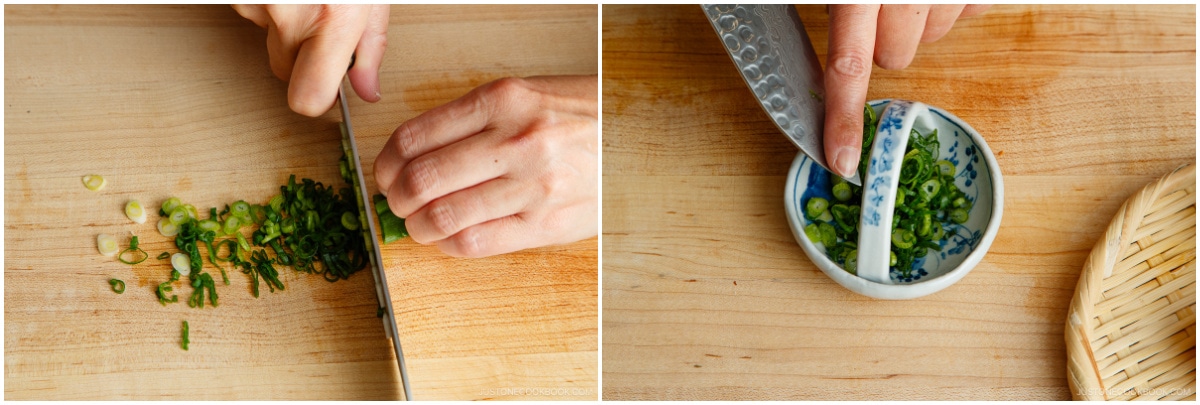
To Serve
- Enjoy the Onsen Tamago either warm or at room temperature. Crack the egg into a small bowl, pour the dashi-based sauce into the bowl, and garnish with the sliced green onion as a part of a Japanese breakfast. Try the egg on top of steamed rice with a splash of soy sauce. It’s also delicious in a rice bowl, on top of Japanese curry rice, in hot noodle soup, or on a plate of cold udon or ramen noodles. See below for serving ideas.
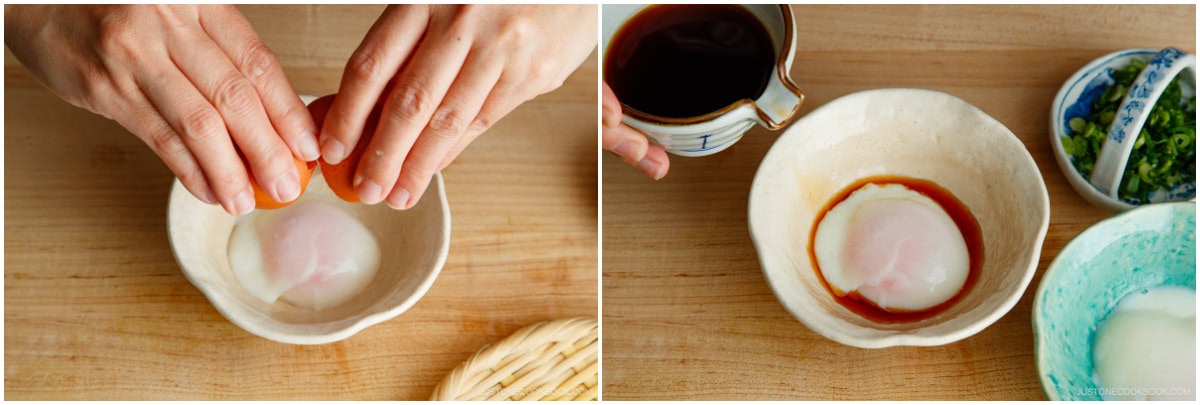
To Serve Onsen Tamago in Other Dishes
- Top a rice dish: Onsen Tamago is a protein-rich topping for fried rice like Kimchi Fried Rice and Garlic Fried Rice. Try adding one to finish a Japanese curry rice plate like Japanese Dry Curry, Keema Curry, Chicken Curry, Vegetarian Curry, and Beef Curry.
- Add it to a rice bowl: It‘s a silky and rich topping for Gyudon (simmered beef bowl) and Yakiniku Don (grilled beef bowl). It also works beautifully in a poached-egg version of Tamago Kake Gohan.
- Put it in noodle soup: Up the protein and add one to your Kake Udon (classic udon noodle soup), Vegetarian Udon, Cold Tanuki Udon, and classic Soba Noodle Soup. It‘s also great in Shio Ramen, Miso Ramen, Vegetarian Ramen, Shoyu Ramen, and Mazesoba (Japanese brothless ramen).
- Top a main dish: Add one to your Hambagu (Japanese hamburger steak), Nikomi Hambagu (stewed hamburger steak), Loco Moco, and spaghetti carbonara (my favorite). It also works well on Avocado Toast.
- Put it in your soup and hot pot: Bulk up your Japanese soups by adding one to classic Miso Soup, Cabbage and Onsen Tamago Miso Soup, Cold Miso Soup (Hiyajiru), and Zosui (Japanese rice soup). It‘s delicious in Nabeyaki Udon, Miso Nikomi Udon, and Hot Pot for One, too.
To Store
- You can keep the uncracked Onsen Tamago for 1–2 days in the refrigerator. To reheat, remove it from the refrigerator and bring it to room temperature. To warm it up further, place it in a bowl of 160ºF (70ºC) water for 10 minutes. Do not reheat higher than that; otherwise, the heat will cook the egg. Keep any leftover sauce in the refrigerator for 4–5 days.
Nutrition
Editor’s Note: This post was originally published on January 22, 2015. It was republished with a new video, new images, and more helpful content on April 19, 2024.









For those of you who live at a high altitude (my home ~6,200ft), I tended to get the best results with 21 minutes
Hi O. Cornali, Thank you so much for trying Nami’s recipe and sharing your experience with us.
This helps other readers who live at high altitudes. Thank you very much!
Attempted this recipe. Followed to a T, whites were raw.
Hello, there! Thank you for testing Nami’s recipe!
We’re sorry to hear that your egg did not turn out well. Have you measured the water temperature during the whole process? The difference could be due to a difference in temperature. Thank you for sharing your experiences.
4/2025: FYI: “use only LARGE eggs” presently in Japan it is almost impossible to find them. Only small (med. Sometimes) available. Sadly, I buy the packaged onsen eggs with the sauce included.
Hello, Yuki Thank you for reading Nami’s post and trying her recipe!
The egg sizes differ by country. In Japan, 50g of eggs without shells is referred to as size M. Hopefully, this helps!🤗
Thank you for the recipe!!! Made your karaage chicken, onsen egg, and Purin for dessert at a dinner party and everyone really enjoyed it. With the onsen eggs, I used less cold water (125ml) and covered with a tea towel (silly idea of me) because I thought my pot was pretty thin. My eggs ended up just a bit overdone after 20mins, so hopefully next time I’ll get it right.
Is there a tip for getting them out of the shell? My eggs were pretty fresh and ended up stuck to the shell and because the eggwhite was soft, they just got torn apart when I tried to peel them.
Hello, Kira. Thank you for trying Nami’s recipes!
We are delighted to hear that everyone enjoyed the meal. Onsen Tamago is typically easy to crack open and drop into the bowl without needing to be peeled. If the egg white sticks to the shell, you can use a spoon to gently scrape it out. We hope Nami’s video helps you achieve the perfect softness for the eggs.
Jika ingin menggunakan banyak telur. Apakah saya tidak perlu mengikuti resep air. Saya akan mengatur suhu air mengikuti resep?
Hi, Yaya! Thank you for trying Nami’s recipe.
Yes. Cooking multiple eggs at once requires careful attention to temperature. We hope this recipe works for you.🤗
For a thin bottom pan all I can confirm for now is that 3/4 cup is too much cold water. I wasn’t sure if my pan was thin bottomed bc it SEEMED t o me to have a thick bottom, but I found out this way that I have a thin bottomed sauce pan…
Mine were still a quite bit raw when I followed these instructions exactly. To finish cooking them I submerged them (after they had cooled down already) again back in warm water that was between 120-170 degrees. I forget how much longer I did that for but it was significant, maybe like 20-25 min more including the variety of cooling down water time and rewarming time (I would come back and pour in some hot water from a kettle and I looked at the thermometer in the water aiming for it be around 160s)… after all that, it was like well on its way to soft boiled but I think you could still call it an onsen egg, it was quite delicious. I was shocked that there was no stinky egg smell when I opened it.
Next time I try again I’ll experiment with only 1/2 cup and maybe a longer wait and try to give a better idea of how much time, sorry i’m not more specific and helpful for now.
Serious eats has an onsen egg recipe for 167 degrees and 13 min only. I’d like to try that one too
Hi Mimi! Thank you for trying Nami’s recipe and for sharing your experiences with us!
I can’t find the faq that says the pan substitutes :l
Hi Ky! Sorry, it looks like no one has tried a lightweight or thin-bottomed pot method and left a comment so far… If anyone leave a comment, I’ll update in the FAQ section. Thank you!